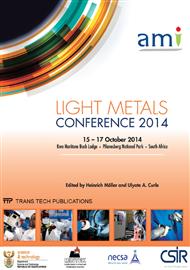p.47
p.55
p.61
p.67
p.74
p.81
p.90
p.96
p.103
Rotational Rheology of A356 Semi-Solid Alloy at Low Solid Fractions
Abstract:
The main goal of investigations on semi-solid metal processing is to produce complex parts with enhanced mechanical properties. Flow behavior and die filling in semi-solid processing is an intrest area of researchers. A comprehensive understanding of the behavior of the under investigation metallic slurry is the design key of a successful manufacturing process. In this way the material’s transient response is very important for understanding of the rheological properties and also further commercial development of the process. The material used in this research is an Al-Si alloy which is widely used in automotive and aerospace applications. The experiments were conducted using a Searl rheometer which is specially designed for high temperature rheological measurements. For rheological tests of semi-solid alloy in different solid fractions, the isothermal holding and shear rate step change experiments were examined. Using practical rheological results, a single phase thixotropic model has been derived and adopted with measurements. The investigated alloy behavior was obviously thixotropic which is quantified in a theoretic model. Also instantaneous rheopectic behavior was observed for this alloy. The state of the microstructure has been applied through a structural parameter. The presented model for A356 alloy fits well with the experiments.
Info:
Periodical:
Pages:
74-80
Citation:
Online since:
October 2014
Authors:
Price:
Сopyright:
© 2014 Trans Tech Publications Ltd. All Rights Reserved
Share:
Citation:


